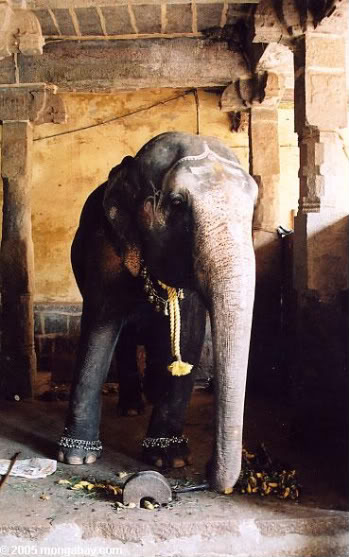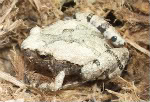A herd of 12-13 elephants has caused havoc in the Kandhamal district of India, reports the BBC. The elephants have completely destroyed 500 homes, left seven dead, and sent another 500 people to camps for shelter.
“We have housed over 500 people in two camps with adequate food and a medical team,” local administrator Krishen Kumar told AFP. “Most people have lost their thatched houses, destroyed by the wild herd. We have the mandate to open more camps until the forestry department is able to dispel the elephants.”
 Captive elephant in India. Humans and elephants have a close relationship in India: for millenia elephants have been used for labor and transportation. |
While it is not clear why this herd of elephants left their home in the Lakheri sanctuary, scientists usually point to continuous habitat destruction as the reason for migrating herds of elephants. With smaller and smaller suitable habitat elephants will invade villages for food.
Such attacks are not uncommon in India. Last year a single elephant killed seven people and injured 24 others. Usually attacks that result in the loss of life are by individual ‘rogue’ elephants.
The Asian elephant is considered Endangered by the IUCN. They are threatened by poaching for their ivory tusks and habitat loss. The Indian elephant is a subspecies of the Asian.
Related articles
Frogs species discovered living in elephant dung

(06/10/2009) Three different species of frogs have been discovered living in the dung of the Asian elephant in southeastern Sri Lanka. The discovery—the first time anyone has recorded frogs living in elephant droppings—has widespread conservation implications both for frogs and Asian elephants, which are in decline. “I found the frogs fortuitously during a field study about seed dispersal by elephants,” Ahimsa Campos-Arceiz, a research fellow from the University of Tokyo, told Monagaby.com.
Vital corridor for Asian elephants to be severed by government development in India

(04/05/2009) The largest wild population of Asian elephants in the world is threatened by development over a 2.5 kilometer wide corridor, according to Rainforest Information Centre which is apart of an international campaign to change the location of the development. The corridor, located in the Western Ghats of India, is the last unbroken forest leading the elephants from wet season to dry season feeding grounds. Unfortunately the corridor also connects two different Indian states: Kerala and Karnataka.
High ivory prices in Vietnam drive killing of elephants in Laos, Cambodia
(02/19/2009) Indochina’s remaining elephants are at risk from surging ivory prices in Vietnam, according to a new report from the wildlife trade monitoring network TRAFFIC.













